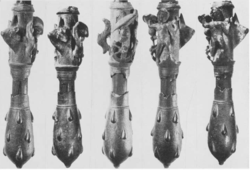
Hercules' Club (amulet)
Encyclopedia

Roman Empire
The Roman Empire was the post-Republican period of the ancient Roman civilization, characterised by an autocratic form of government and large territorial holdings in Europe and around the Mediterranean....
and Migration
Migration Period
The Migration Period, also called the Barbarian Invasions , was a period of intensified human migration in Europe that occurred from c. 400 to 800 CE. This period marked the transition from Late Antiquity to the Early Middle Ages...
era artefact type.
Roman era Hercules's Clubs appear from the 2nd to 3rd century, spread over the empire (including Roman Britain
Roman Britain
Roman Britain was the part of the island of Great Britain controlled by the Roman Empire from AD 43 until ca. AD 410.The Romans referred to the imperial province as Britannia, which eventually comprised all of the island of Great Britain south of the fluid frontier with Caledonia...
, c.f. Cool 1986), mostly made of gold, shaped like wooden clubs.
A specimen found in Köln-Nippes bears the inscription "DEO HER[culi]", confirming the association with Hercules
Hercules
Hercules is the Roman name for Greek demigod Heracles, son of Zeus , and the mortal Alcmene...
. Indeed, already Tacitus
Tacitus
Publius Cornelius Tacitus was a senator and a historian of the Roman Empire. The surviving portions of his two major works—the Annals and the Histories—examine the reigns of the Roman Emperors Tiberius, Claudius, Nero and those who reigned in the Year of the Four Emperors...
mentions a special affinity of the Germans for Hercules, stating
- they say that Hercules, too, once visited them; and when going into battle, they sing of him first of all heroes.
There are two basic types, the smaller type (ca. 3 cm) cast in molds,
and the larger (ca. 5 cm) wrought from sheet metal. A type of bone pendants found in Iron Age (Biblical period) Palestine is also associated with the Club-of-Hercules jewelry of the Roman era (Platt 1978). A votive mace made of bronze found in Willingham Fen, Cambridgeshire
Willingham, Cambridgeshire
Willingham is a medium to large village in Cambridgeshire, England. It is located on the edge of the Fens just south of the River Ouse. Driving north from the village one may observe the characteristic elevated straight roads and black soil....
in 1857 follows the Roman model in shape and the representation of wooden knobs on the club, but adding indigenous (Celtic) iconography by depicting animal heads, anthropomorphic figures and a wheel at the club's base.
In the 5th to 7th centuries, during the Germanic migration, the amulet type rapidly spreads from the Elbe Germanic area across Europe. These Germanic "Donar's Clubs" were made from deer antler, bone or wood, more rarely also from bronze or precious metals. They are found exclusively in female graves, apparently worn either as a belt pendant, or as an ear pendant.
The amulet type is replaced by the Viking Age
Viking Age
Viking Age is the term for the period in European history, especially Northern European and Scandinavian history, spanning the late 8th to 11th centuries. Scandinavian Vikings explored Europe by its oceans and rivers through trade and warfare. The Vikings also reached Iceland, Greenland,...
Thor's hammer
Thor's Hammer
Thor's Hammer may refer to:* Mjölnir, the hammer wielded by Thor in Norse mythology*Thor's Hammer , a garage rock band from Iceland*Thorr's Hammer, a death/doom band from Ballard, Washington...
pendants in the course of the Christianization of Scandinavia
Christianization of Scandinavia
The Christianization of Scandinavia took place between the 8th and the 12th century. The realms of Scandinavia proper, Denmark, Norway and Sweden, established their own Archdioceses, responsible directly to the Pope, in 1104, 1154 and 1164, respectively...
from the 8th to 9th century.

